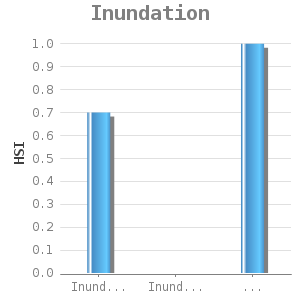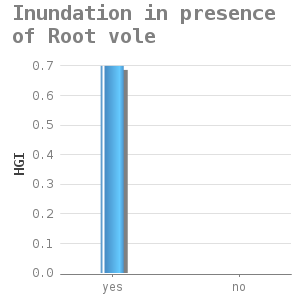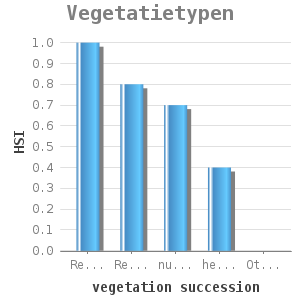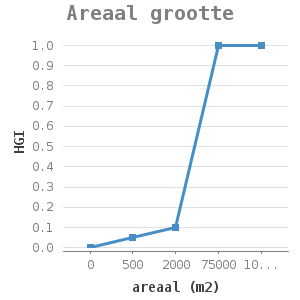Tundra Vole - _Microtus oeconomus _
General Characteristics
Description Habitat
Occurrence
The tundra vole is found from North Scandinavia through Siberia and Alaska to Canada. The subspecies arenicola can only be found on Texel and the low-lying parts of the Netherlands. This makes it the only Dutch endemic vertebrate. Based on its occurrence, five regions in The Netherlands have been identified which vary in natural characteristics, water management and soil1.
1. Friesland
2. Texel
3. North-Holland centre
4. Peat meadow areas Holland-Utrecht
5. Delta region
The conditions that determine if a habitat is suitable for the tundra vole differ per region. Specific habitat characteristics are a dynamic environment with varying water levels and meadows with abundant cover. When faced with competition, this species clearly prefers wet areas, such as reed-land, marshes, swamp meadows, moist dunes and periodically flooded areas or high vegetation areas with mostly grass-like plants 3. The area, however, must not be too covered or too open4. The tundra vole is a good swimmer and is able to reach small islands, where it has no competition of other voles.
The tundra vole has to compete with other vole species, especially with the field vole and the common vole 1, 5. The prevailing conditions determine which vole occurs. If the field vole is found, the chance of finding a tundra vole is reduced by 44-61%. For field voles, a negative effect was only monitored in a habitat with optimal conditions for field voles and not for tundra voles 6. The bank vole can also be considered as a competitor, but to what extent is uncertain 2. The field vole clearly prefers a habitat with a stable water level to habitats that regularly flood7.
The tundra vole can move easily in water but also on land (up to approx. 3200m), its mobility is higher than that of the field vole. There is also a relation with the morphology of the habitat. If there are enough places to hide, this is an advantage for the field vole as it can quickly seek refuge during flooding and when the water drops it can colonize the habitat again. However, if there are just few hiding places, the tundra vole has the advantage, especially if the hiding places are located near the habitats outer sections 4. There is however only a strong suspicion of the competition between the field vole and tundra vole, no data is available to confirm or deny it5.
Food habitat and strategy
The tundra vole is a strict herbivore and is not selective when choosing food. It feeds (among others) on young reed vegetation and Juncaceae species. In winter, they also feed on bark, seeds and roots and in summer on herbs. In winter, they stockpile food in shallow chambers 5.
Breeding (reproduction) and migration
The tundra vole is territorial. The territory of a male can cover approx. 20 metres square5. Its radius of action is estimated at a maximum of 800 metres per day. In The Netherlands, Germany and Austria, the breeding season lasts from April to October. In more northern parts it lasts from May to September 8.
Age and mortality
Life expectancy unknown, calculated at max 1.4 year in free nature and 1.8 year in captivity.
Female sexually mature 30 days
Male sexually mature 48 days (42-56)
Gestation 20-22 days
Breeding season April - September
Nursing period 19 days
no of young per litter 7 (3-8)
no of litter per year 3.5 approx. 5 max
Interval between litter 29 days 1
Dose-effect relations
Flowdiagram
The total habitat suitability is calculated as follows:
if(HSI_Inundation<1, min(HSI_Inundation,HSI_Aardm,HSI_Vegetation), HSI_Vegetation)
If the suitability for inundations equals one than:
graph[
rankdir=LR]
nodesep=0.5
"node0" [
label = "Inundation|Vegetation type"
shape = "record"
];
"node3" [
label = "Size of area"
shape = "record"
];
"node0":f1-> "node3" [style=italic,label="minimum"]
[
id = 2
];
"node4" [
label = "HSI total"
shape = "record"
];
"node3":f1-> "node4"
[
id = 3
];
If the suitability for inundations is below 1, it must be checked whether or not the root vole Microtus agrestis occurs here.
graph[
rankdir=LR]
nodesep=0.5
"node0" [
label = "Inundation|Root vole|Vegetation type"
shape = "record"
];
"node3" [
label = "Areaal grootte"
shape = "record"
];
"node4" [
label = "HGI totaal"
shape = "record"
];
"node0":f1-> "node3" [style=italic,label="minimum"]
[
id = 2
];
"node3":f1-> "node4"
[
id = 2
];
Dose-effect relations

Inundation |
HSI |
|---|---|
Inundation in winter |
0.7 |
Inundation in summer |
0 |
No inundation |
1 |
The tundra vole is a good swimmer, winter inundation is therefore no problem. But there is a chance of drowning when their holes flood. Inundation outside the winter season can result in death of their young, as they cannot yet swim properly 5.

Inundation in presence of Root vol |
HSI |
|---|---|
yes |
0.7 |
no |
0 |

vegetation succession |
HSI |
|---|---|
Reed vegetation (wet) |
1 |
Reed vegetation (dry) |
0.8 |
nutrient poor grass land (wet), reed, hydrophilous tall herb fringe communities |
0.7 |
herbaceous grassland, open fields |
0.4 |
Other vegetation types |
0 |
Please note that the vegetation information of the Volkerak-Zoommeer projects is derived from the water plant module (riverbank vegetation, HSI>0.5) and the ecotope map, as was used previously in the project 'Seizoensgebonden Peilen IJsselmeer' (only in Dutch). In addition, a vital population of 50 males and 100 females need a habitat of 75000m2 with suitable vegetation. Smaller areas can function as a temporary habitat 10.
Onzekerheid en validatie
De rekenregels zijn gevalideerd op de Makkumer Waarden, waarbij een goede habitatgeschiktheid werd gesteld op een waarde van 0.7 en hoger. De meetdata, uit 2006 en 2008, zijn afkomstig van De Zoogdiervereniging![]() .
.
Aanwezigheid goed voorspeld |
0.75 |
|---|---|
Aanwezigheid fout voorspeld |
0.25 |
Aafwezigheid goed voorspeld |
1.0 |
Afwezigheid fout voorspeld |
0.0 |
meetdata |
modeldata |
|---|
Opmerkingen en aanbevelingen
Zoals opgemerkt is er niet met volstrekte zekerheid aan te geven in welke mate en vorm de noordse woelmuis concurrentie ondervindt van de aardmuis (en veldmuis). Echter, omdat het van wezenlijk belang is wordt in de opzet voor het HABITAT model voor de noordse woelmuis de concurrentie van de aardmuis meegenomen op basis van algemene informatie. Wanneer uit onderzoek blijkt dat er locaal geen sprake is van concurrentie, of in andere mate, tussen deze twee soorten, dan zal de rekenregel voor de aardmuis uit het model verwijdert en /of gewijzigd worden. Met betrekking tot vluchtplaatsen wanneer inundatie plaats heeft: hiervoor is nog geen model beschikbaar.
Toepasbaarheid
Andere standplaatsfactoren zoals begrazingsdruk, maaibeheer en voedselrijkdom zijn ook van belang voor de mate van voorkomen van de Noordse Woelmuis. Omdat deze factoren niet veranderen onder invloed van de verschillende varianten in studie 3 zijn ze niet van invloed op de uitkomst van de habitatanalyse in deze studie. Wel kan in het doorrekenen van toekomstscenario's hier rekening mee worden gehouden.
De rekenregels kunnen toegepast worden op de grote meren van Nederland.
Voorbeeld project
Habitat analyse in het kader van de Planstudie/MER voor Krammer, Volkerak en Zoommeer. WL report Q4015. 2006
Referenties
1 Witte van den Bosch, R.H., D.L. Bekker & J.J.A. Dekker, 2009. Landschapsdynamiek voor de noordse woelmuis, Landschap 2009-3: 146-152.
2 Haasnoot, M. en Van de Wolfshaar, K.E.. Habitat analyse in het kader van de Planstudie/MER voor Krammer, Volkerak en Zoommeer. WL report Q4015. 2006
3 http://www.minlnv.nl/natura2000![]()
4 La Haye, M., J.M. Drees en R.C. van Apeldoorn: "Beheerplan Noordse Woelmuis". Ministerie van LNV, 2004
5 Witte, R.H., 2010. Ecoprofiel noordse woelmuis Microtus oeconomus arenicola. Soortinformatie ten behoeve van modellering, mitigatie, compensatie en ecologische herstelmaatregelen Zoogdiervereniging, Nijmegen.
6 Nieuwenhuizen, W., M.J.J. La Haye & F. Mertens, 2000. De noordse woelmuis in Fryslân. Naar een duurzame instandhouding. Alterra-rapport 149, iSSN 1566-7197.
7 Bergers, P.J.M., R. van Apeldoorn & H. bussink, 1994. Spatial dynamics of fragmented root vole (Microtus oeconomus) populations: preliminary results. Pol. Ecol. Stud. 101-105.
8 http://nl.wikipedia.org/wiki/Noordse_woelmuis![]()
9 Hollander, H. en J.O. Reinhold. 1999. HSI-Modellen voor 5 oevergebonden zoogdiersoorten. Voorlopige versie op basis van de huidige ecologische kennis. Rijkswaterstaat Dienst Weg en Waterbouwkunde. DWW Rapport W-DWW-99-011.
10 Haasnoot, M., Kranenbarg, J. en van Buren, R.. Seizoensgebonden peilen in het IJsselmeergebied. WL report Q3889. 2005.

